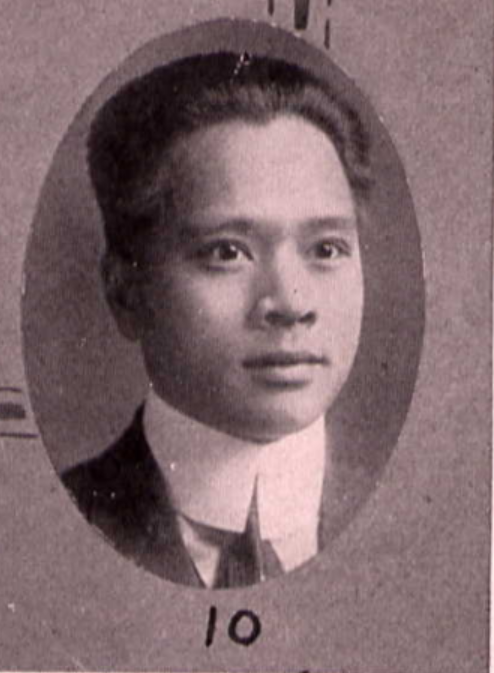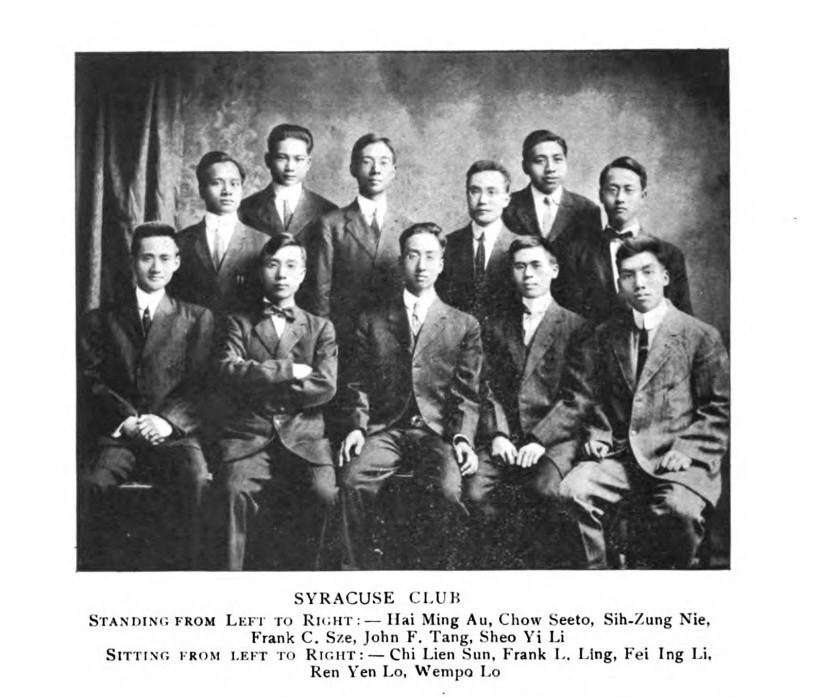I obviously have not started this project from the very beginning, but it’s never too late to go back to the start, is it? So this week I will be writing about Harry Hak-Min Au (區克明, pinyin Ōu KèMíng, Cantonese Jyutping Au1 Haak1Ming4), the first person listed in most of my CSA Directories. Just a brief content warning: this blog post will briefly contain some historical racist language.

H. M. Au was born on 16 January 1894 in Canton, China (link to WWI draft card). Unfortunately, we know very little about his early life – H. M. Au self-reported that he entered the US in 1909, but I haven’t found any ship’s manifests or entry paperwork, so I don’t have any relatives or travel companions for him. I do know two facts about his pre-US life, though: he spent time in the military, and he attended Canton Christian College.
H. M. Au’s military service is attested on his WWI draft card. He reports that he had 4 and a half years of military experience as a student at military school, both in the US and China. The US experience makes up the half-year: he was a 4th class student at Virginia Military Institute in 1911-12 (VMI Official Register 1911-12, pg. 80). According to the VMI online archives, he matriculated on 27 January 1912, so he was not there for the entire 1911-12 academic year (VMI Archives Historical Rosters). So the other 4 years of his experience must have been at a military school in China, but I don’t have any pre-US records of him at any Chinese military academy.
I similarly don’t have any records of him at Canton Christian College, but the early records of the school are hard to come by. Harvard University has a “Trustees of Lingnan” archive (Lingnan being the name of CCC after about the 1950s), but it is scant on early paperwork, a problem I ran into when researching E. J. Chu, another former CCC student. H. M. Au does show up in a “CCC Students in the US” directory from 1917, so I know he was definitely a student there, but more specifics can’t be found at this point.
Like many Chinese students, he needed to repeat some high school classes before going on to university, so he enrolled at a boarding high school: Cook Academy in Montour Falls, New York. This is where he is in the 1911 CSA Eastern Directory. I would guess that he was at Cook Academy for two years – from 1909 until 1911 – because the Canton Christian College President’s Report of 1911-12 lists him as already being a student at Syracuse University (pg. 65), and the later picture of the Syracuse Chinese Club with him in it is dated November 1911.
He started at Syracuse in the fall of 1911, and as mentioned before, took his spring 1912 semester at VMI in Lexington, Virginia. The 1911-12 CSA Directory lists him as living at Sims Hall at Syracuse, so he must have filled his address card out before he left for VMI. He returned to New York for the fall of 1912, since he doesn’t show up in any other VMI Registers, and he starts showing up at Syracuse again in fall of 1913. The 1911 and 1911-12 CSA Directories listed him as a member in good standing of the organization, but he got more involved in the Chinese Students’ Association starting in 1913, both at the local Syracuse level and at the national level. He was elected Chinese Secretary of the Eastern Chinese Students’ Association at the August 1913 conference (Chinese Students’ Monthly, Vol. 9, No. 1, pg. 60). He was also the chairman of the Syracuse Chinese Club in the spring of 1914 (Chinese Students’ Monthly, Vol. 9, No. 6, pg. 502)

H. M. Au was also involved in the Syracuse Cosmopolitan Club. I think I’ve mentioned the Cosmopolitan Clubs before, but they were an association of international students’ clubs at universities around the US. They were based on the Corda Fratres clubs in Europe. Syracuse was one of the universities that had an active Cosmopolitan Club, and H. M. Au was a member, starting with his first full year at Syracuse, 1912-13 (Syracuse Onondagan 1913, pg. 376). He was also listed as a Cosmopolitan Club member in the 1916 and 1917 yearbooks, serving as the president of the club in his senior year (Syracuse Onondagan 1917, pg. 57).
According to both city and CSA directories, H. M. Au moved around a bit while he was studying at Syracuse. In the 1914 Syracuse city directory, as well as the CSA 1914 Directory, he was living at 921 E. Adams Street in Syracuse. The CSA directory adds that he was studying Chemistry and entered the US in 1909. But by 1915, he had moved to 716 Irving Street, according again to both the Syracuse city directory and the CSA directory.
1915 was the year he started branching out into other activities. The 1917 yearbook mentions the tennis club, but he seems to have been extremely active in sports. He rowed crew for Syracuse University and was the first to try out for the varsity team, as reported in the charmingly-titled article “Syracuse Coxswain a Chink” (Milwaukee Journal, 29 Mar 1915). He was a member of the Geology and Chemistry clubs, and was actually studying sugar manufacturing systems in the US as preparation to manage a factory in Canton upon his return to China (Chinese Students’ Monthly, Vol. 11, pg. 451).
In 1916, H. M. Au moved again, to 102 Madison St., an address that appears in the 1916 and 1917 Syracuse city directories as well as the WWI draft card linked earlier. He graduated from Syracuse with his BS in Chemistry in 1917, but he seems to have stayed in the US for a little longer than that, since he shows up in a few other sources through 1918. The 102 Madison address was repeated in the 1917-18 Directory of Canton Christian College Students in America (Trustees of Lingnan Archives, Harvard University). H. M. Au also shows up in the 1918 CSA Directory as having earned a BS in Chemistry from Syracuse.
Again, I don’t have any ship’s paperwork for his exit, but I think he left the US at some point in the latter half of 1918. He moved back to Canton, but I don’t have any record of him working for the capitalist who sponsored his investigation of sugar production in the United States. In fact, according to one Chinese source, he entered military training again, but had to leave due to his mother’s illness (original text: “旋入陸軍大學,未及一年,因母病歸國”, translation: “He immediately entered military college, but he didn’t stay there a year; due to his mother’s illness he returned home”).
He stayed in the Canton area, helping to set up the Western Returned Students’ Club in 1919 (Canton Times, 22 Sept 1919). The previously-linked Chinese source claims that he opened an import/export business in Canton, and he must have been well-connected, because he was the one who secured the use of the 4th floor of the Canton Bazaar for club meetings. He was elected assistant to the Social Committee at their second meeting in September. In their October meeting, they discussed their support of a local boycott (Canton Times, 6 Oct 1919). They had a banquet in late December, at which H. M. Au told some “smart colloquial jokes” (Canton Times, 1 Jan 1920).
Sadly, that’s the end of the information I have about H. M. Au. I assume he stayed in Canton his whole life, because he doesn’t show up in newspaper articles from Shanghai or Peking, and unfortunately the database I use only has issues of The Canton Times from 1919-1920. So that is where we will leave the story of H. M. Au: running his business in Canton and telling smart jokes.
One thought on “H. M. Au (區克明)”